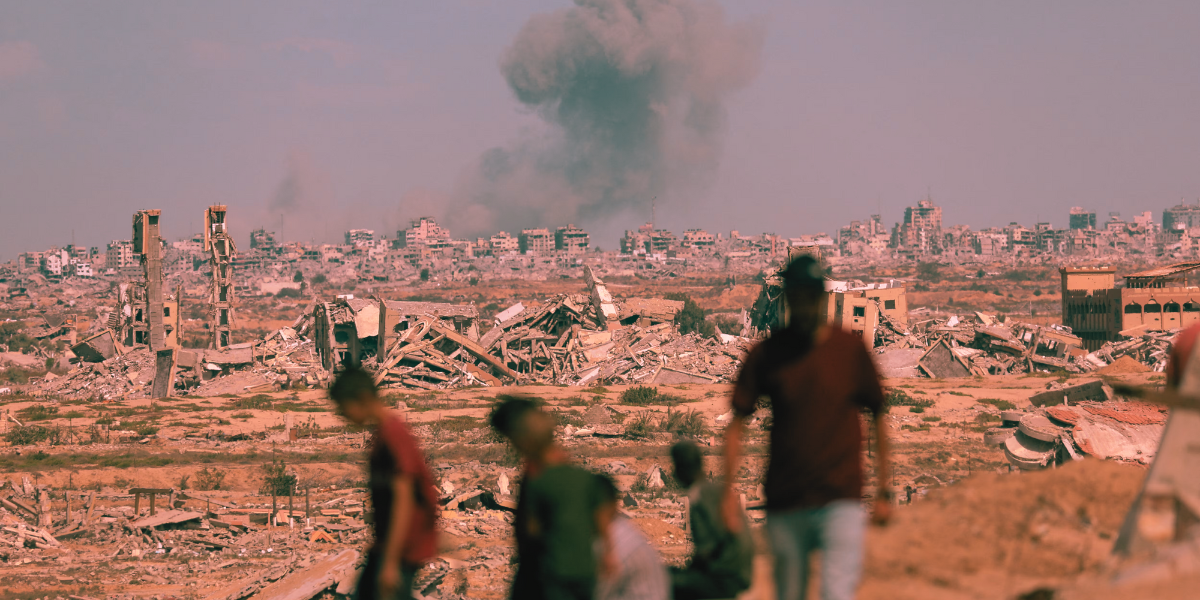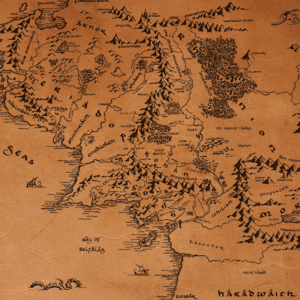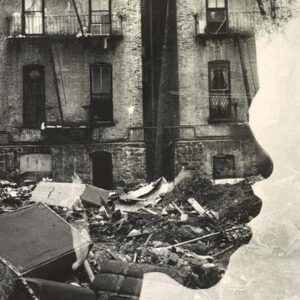
The History of the Relentless, Decades-Long Siege on the People of Gaza
“The average young Gazan measures his age by how many of those wars we survived.”
My first memory of Gaza is an airstrike. My second is an Israeli checkpoint. My third is of frequent demonstrations. And my fourth is of my overcrowded UNRWA school for Palestinian refugees. Gaza is a giant refugee camp; a “huge concentration camp” as Israel’s (then) national security chief, Giora Eiland, called it back in 2004. At the same time, it’s a unique place of vivid culture, rich diversity and huge yet unattainable potentials—all reminders that its bleak present is purely man-made and was completely preventable. It’s also an unbreakable fortress of rebellion, resistance and insurgency. And it is a place of many contradictions and paradoxes.
Growing up in Gaza, I lived through three wars, ten major Israeli military operations and two full ground invasions, all within less than two decades. But none of them came anywhere near the genocide of 2023–25 in terms of magnitude, severity and sheer brutality. “There is a thick stench of death, of rotting corpses and gunpowder, enveloping all of Gaza,” a friend who visited the besieged enclave in February 2025 told me. “It’s everywhere. It’s all over.” He compared it directly to the 2003 Darfur genocide, which he had also experienced.
There are two questions Gazans have usually asked each other since the start of this campaign of unrelenting and systematic destruction, starvation, displacement and mass killing. The first is, “How many family members have you lost?” The answer is always in the dozens, no matter who you ask. I personally stopped counting by February 2024. I couldn’t bear it after Israel killed thirty-four of my relatives. But every time I opened my social media apps, there were new pictures of relatives, colleagues, loved ones, neighbors and friends in grey, relegated to the past tense from “is” to “was.”
But every time I opened my social media apps, there were new pictures of relatives, colleagues, loved ones, neighbors and friends in grey, relegated to the past tense from “is” to “was.”
The second question is, “Is your home still standing?” Virtually every single person I know has had their home bombed, burned down, bulldozed or damaged to the point of becoming un-inhabitable. Israel wiped out entire cities with nothing left but an abundance of rubble mixed with thousands of corpses stuck underneath. Watching from outside Gaza, I stood paralyzed and powerless the entire time the genocide was unfolding. I didn’t dare tell any loved ones to “stay safe,” because I couldn’t provide any advice whatsoever on what they could do to increase their chances of survival.
“Seek shelter at a UN school,” “go to a hospital,” “stay near journalists,” “stay near international organizations”. . . any advice that would have previously been helpful now became a trap as Israel went on to destroy the vast majority of UN schools and hospitals and directly slaughter the highest number of journalists and humanitarian workers ever recorded within such a short space of time.
Even in our darkest imaginations, no one could have conceived of Gaza’s streets littered with the decomposing bodies and skeletal remains of our loved ones; that stray dogs and cats would be filmed feasting on those bodies; that Israeli soldiers would confess to driving their tanks over hundreds of living and dead humans and crushing them into mush; that parents would scour the streets looking for hacked pieces of human flesh to put randomly in plastic bags and consider each 10–20 kilos a child; that thousands of kidnapped Palestinians in Israeli “torture camps” would be systematically and routinely beaten, raped, forced to perform sexual acts on each other, forced to drink from toilets, starved to near death, blindfolded and chained 24/7 in crowded cages whose air is filled with the “putrid stench” of “neglected wounds left to rot” and amputated limbs, that the perpetrators would document and brag about their atrocities every minute of the day; and that the world would watch all this live-streamed and yet allow it to continue unconstrained.
They told me it was thunder the first time I heard an airstrike.
How, then, is one to understand this total war? How far back into history does one need to go to judge these actions? Is it sufficient to look at the atrocities committed on October 7, 2023? What led to that fateful day unfolding? Does one need to go back to 2007, when Israel officially imposed its siege on Gaza? Or to Hamas’ violent takeover of Gaza right before that? What about the group winning a democratic election in 2006? Israel’s 2005 unilateral “disengagement” from Gaza? The second intifada? The 1993 Oslo “peace process?” Israel’s closure and separation policy in Gaza since 1991? The first intifada? The 1973 war? The 1967 war? The 1956 war? The 1948 Nakba? The 1947 partition plan? The 1917 Balfour Declaration? Or even further? And why does virtually every Palestinian have those dates memorized by heart? What terrible significance do they hold?
Growing up, my parents never needed to explain the occupation to me. In fact, they actively tried to hide it from me, to shield me from its toxicity, to give me a sense of normal life. They told me it was thunder the first time I heard an airstrike. The strewn rubble and burned furniture I saw all over the street the next morning were self-explanatory.
I became politically aware at a very early age as we travelled back and forth between Gaza and Egypt. My late father tried to maintain that routine to renew our Egyptian residency permits annually out of fear Israel would expel us from our home again one day. In the original Nakba of 1948, they had forcibly uprooted his father from the land he had just bought a couple of miles to the east of the Gaza Strip, and wiped out his entire village.
In Gaza’s Shati refugee camp, my grandfather built a modest shack, brick by brick, on the spot where his tent was erected. He planted a fig tree to remind him of his hometown. UNRWA’s schooling system crucially contributed to my father becoming a genius doctor whose memory instills pride in me, after Israel made him a barefoot child refugee running around a camp in worn-out rags.
But just as my father and his family tried to breathe a sigh of relief and rebuild a fraction of their ruptured lives, Israel kicked them out again in 1967, this time to Egypt. They were allowed back in 1994 with the Oslo Accords—but the 1990s “peace process” didn’t assuage my father’s fear of another expulsion. “They will do it to us again one day,” my dad often said. And he was right. That’s why I remember those dates, and why every Palestinian does as well. They are not just national milestones, but as Irfan elaborates, they are intimately personal and traumatic to each of us.
In 1995, the New York Times reported that Palestinians in Gaza were calling the Strip an “open-air prison.” Every time we tried to travel, we had to sign up months in advance. Israel opened and closed Gaza’s borders with Egypt arbitrarily and without warning. We would only learn about our time of departure the night before, rushing to pack then squeezing into an overcrowded car the next day. Sand dunes, ruined streets marked by the tracks of IDF tanks, destruction, bullets. . . a vivid picture was forming in my head of the stark difference between the openness of a cosmopolitan Cairo and the militarization and entrapment of an isolated Gaza.
Sometimes, we’d reach the Rafah crossing only to find out Israel had shut it again at the last minute, as collective punishment for something Hamas had done elsewhere or for pure political pressure. Sometimes, we’d stay with relatives in Rafah because we didn’t want to risk crossing the checkpoint back into Gaza City and having to wait for days there again. Other times it was clear that it would take a while for the crossing to reopen and we’d go back home and wait for a phone call.
“Don’t open any doors or windows,” my mother would say, as we suffocated in the heat, afraid that the soldier would shoot us, as happened to many.
Up until 2005, the crossing was divided into three areas: a Palestinian room, an Israeli hall and an Egyptian hall. To get from the Palestinian building to the Israeli building, we had to cram into an orange taxi that carried us the few dozen meters between them (because Israel dictated we could not walk). Many times, we’d sit in that taxi for hours waiting for Israel to let us in. Once on the Israeli side, we were ordered not to open the windows and to leave the car only through the right-hand doors.
One of the first Israeli soldiers I remember encountering was a soldier at the Abu Holi checkpoint set up in 2001 as punishment for the second intifada. It was named after the owner of the farmland Israel had confiscated to build the barrier on. I never saw the soldier’s face, because he sat in a watchtower manning the checkpoint that Israel arbitrarily closed most of the time. I couldn’t see the whole watchtower either; I glimpsed parts of it as we sat in the car in an endless queue of vehicles under the boiling sun for hours, waiting to make a journey that would otherwise have taken thirty minutes.
No one, not even animals, were allowed to cross on foot. Donkeys were stuffed in cars’ back seats. “Don’t open any doors or windows,” my mother would say, as we suffocated in the heat, afraid that the soldier would shoot us, as happened to many.
At Rafah, we were herded like cattle through crammed corridors at the Israeli-controlled side of the border. There, I could see clearly what the soldiers looked like. Their smirks, their sunglasses, hostile demeanor and the big rifles they pointed at us have been etched in my mind ever since, along with the piercing noise of them yelling and cursing condescendingly in broken Arabic. So has the panicked and powerless look in my parents’ eyes as soldiers seized my eldest brother from the queue and sent him back to Gaza only because he had turned sixteen. It taught me a lot.
Yet I learned more in 2007. We were stuck in Egypt on a medical trip when Hamas took over Gaza and Israel shut down all the enclave’s borders. After Egyptian intervention, a rare exception was made, and we and other stuck Gazans were allowed to return through a different and unusual route: the al-Ouga commercial crossing (Nitzana) between Israel and Egypt.
It was instantly clear that the young Israeli soldiers there had never met a Palestinian or been to the occupied territory. They were different from their peers at Rafah; relatively polite, calmer, they brought us food and water, and provided a wheelchair for an old woman who travelled with us in the shuttle bus. The occupation, this wretched apartheid system, dehumanises us both; it corrupts the souls of the oppressors as much as it ruins the lives of the oppressed.
The average young Gazan measures his age by how many of those wars we survived.
After that, aside from one short medical trip in 2010, we couldn’t travel to Egypt for a decade; Israel’s siege was tightened, and we were locked up in a permanent state of non-life. Israel was at best allowing the luckiest of us to keep our “heads above the water, but nothing more than that” as their defense minister put it in 2018.
In his last days, my dying father longed for figs and other fruit, but thyme and duqqa were the only foods available in abundance under siege. For “security reasons,” Israel had even banned the import of pasta, as Irfan describes later in the book. I went door to door searching for fruit but found nothing. Defeated, I could not bear to bring myself back home that night until I was sure my father was asleep.
New phrases were added to my dictionary. “Hot Winter,” “Cast Lead,” “Pillar of Defence,” “Protective Edge,” “Closed Garden,” “Black Belt,” “Guardians of the Walls,” “Breaking Dawn”. . .Those were the names of Israeli “military operations” that punctuated the endless suffocation imposed on us. They were periodic massacres and killing sprees that Israel would describe as “mowing the lawn.” The average young Gazan measures his age by how many of those wars we survived.
The term “slow death,” however, was the most chronic. I heard it every single day. It resonated even more deeply as I took my first steps into adulthood and found that most people around me had no hope of any meaningful future. Most Gazans who had come of age or graduated from university in 2006 when Israel’s blockade was imposed were in 2023 reaching the second half of their thirties without ever having had a job, despite their impressive educational achievements. They couldn’t afford to fall in love and start a family, because they couldn’t afford to put food on the table or move out of their parents’ homes.
Ali, my childhood friend, was one of the smartest people I’ve ever known. You could have a conversation with him about any topic at all and be impressed by his deep knowledge: EU migration policies, Russia–Ukraine, China–Taiwan, domestic US politics, economic history, climate change, Noam Chomsky, Jordan Peterson. . .We used to talk almost every day; even when I was outside Gaza, I’d call him when his electricity was on.
We would fume, laugh, discuss life, memories, movies, sports and politics. Every time Ali and I talked over the phone, I could always hear a buzzing noise lurking in the background throughout our conversations. It came from the Israeli predator and surveillance drones that have hovered above Gazans’ heads 24/7 since the start of the siege. They are equipped with rockets to shoot to kill at any second. Their noise got loudest at night when the city became quiet.
Ali studied hard, applied for countless jobs and scholarships for a decade, freelanced intermittently, volunteered. . .but he never got a break. Despite his brilliance and intellect, he was prevented from having a full life by being born on the wrong side of Israel’s separation fence. There wasn’t much for him to do in Gaza except count days, months and years.
Every day brought Ali shame and burning rage: when he crawled out of bed and left his room to eat a breakfast meal with his family that he didn’t contribute to; when he asked for pocket money from his parents to buy snacks, clothes or get a haircut; when he went for a walk in the neighborhood with his head bowed in embarrassment and devastation. He hated his birthdays, because each one reminded him that his life was wasting before his eyes.
Ali was killed by Israel in January 2024 at the gate of al-Aqsa hospital in Deir al-Balah, and my world has been in ruins since. I have had no one to mourn him with, because he never had the chance to be known—to work with colleagues or make new friends, to gain a name for himself as a journalist or leave any kind of footprint outside of his immediate family. The toughest thing about his death is that, like most young Gazans, Ali never got the opportunity to experience living, despite how hard he tried every single day.
__________________________________

From A Short History of the Gaza Strip, foreword by Muhammad Shehada. Used with the permission of the publisher, W.W. Norton and Company. Copyright © 2025 by Anne Irfan
Muhammad Shehada
s a Gazan researcher, writer, and human rights advocate. His work focuses on investigating human rights violations in Gaza and the West Bank, and more broadly in the Middle East and Europe, with an emphasis on the treatment of migrants, refugees, and civilians in conflict zones. He is currently serving as the chief of communications and programmes at the Euro-Mediterranean Human Rights Monitor. He has contributed to a wide range of international publications such as The Forward, Al Jazeera, Newsweek, The Nation, and The New Arab.












